I recently took a walk from Penn Station, exploring the newest and final section of the High Line that will open to the public, into Chelsea, south along 4th Avenue and the Bowery, and across the Manhattan Bridge. In times past I would put together a 150-photo epic page describing and illustrating the walk, but these days I’m content to chop it up into sections, like record labels did in the old days with popular albums, periodically promoting “singles” consisting of the songs they thought would sell best for radio play.
I don’t have a marketing research department (years ago I was trying to put one into place but it didn’t work out) so I don’t know what stories or photos will get people to click on the ads or sign up for tours — if I had the magic knowledge I’d take advantage of it — but I do save time and, I’m sure, Forgotten Fans’ patience by composing shorter pages, and so shorter it is. Today I’ll concentrate on the second leg of my walk, down Broadway, 4th and 3rd Avenues, and the Bowery.
GOOGLE MAP: BROADWAY AND THE BOWERY
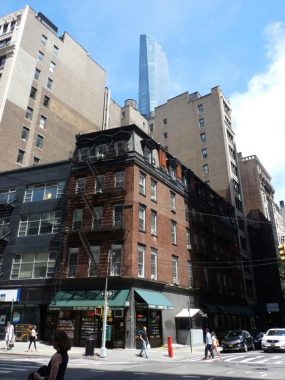
The brick building on the northeast corner of Broadway and West 21st Street has the air of something important about it, as if it has a past, and indeed it had once been a hotel called the Bancroft House. It was constructed in 1858 and likely acquired its French Second Empire trappings like a slanted roof and dormer windows when the style was popular in the 1870s and 1880s. By the 1920s, there was still a hotel there, but it was the Hotel Courte by then.
When I was working at Tiffany & Co. offices at nearby 200 5th Avenue in 2013 and 2014 the 21 Berry deli on the ground floor was a go to place for yogurt, soda and chips. While my Tiffany’s compatriots were at Eataly, I was probably the only Tiffany’s office worker patronizing Papaya King on 7th avenue and West 23rd.
Broadway, formerly a busy two-lane thoroughfare, is now just one southbound lane as bike lanes and pedestrian plazas have accumulated along its length. Broadway’s full traffic mojo is now found only north of Columbus Circle.

Just as Macy’s moved uptown from its original location, so did Lord & Taylor. The store’s 3rd location was in this French Second Empire building, on the southwest corner of 901 Broadway and West 20th Street. L&T was here from 1873-1914 in one of NYC’s larger cast iron front buildings. British immigrant Samuel Lord and George Washington Taylor established their first dry goods store on Catherine Slip on the Lower East Side in 1826.
Lord & Taylor’s 5th Avenue flagship was open from 1914 until its closure in early 2019.

900 Broadway was constructed in 1887 as the Goelet Building, as the original owners were in the Huguenot French family who had been in the Northeast since the early colonial era. It was an early solo design for Stanford White, who had designed the original Madison Square Garden that was actually on the northeast corner of the square. White, in a partnership with Charles McKim and William Mead, designed the original Penn Station and many other architectural masterpieces. He never lived to see Penn Station completed; after, it is said, he sexually abused showgirl Evelyn Nesbit, he was shot dead by her husband, Harry Thaw.

McKim, Mead and White were known for larger, more elaborate buildings, but the architects built the compact Warren Building at 905-907 Broadway at the NW corner of West 20th. The building is festooned with ornamentation as was the wont in 1897, and chamfered (angled) corners.
The Theodore Roosevelt Birthplace, or the building constructed in 1923 to look exactly like it, a National Historic Site, can be found at 28 East 20th Street, just east of Broadway. The Women’s Roosevelt Memorial Association purchased the property in 1919 and rebuilt the house, stocking it with items owned by Roosevelt’s sisters and wife. There’s a comprehensive history of Roosevelt’s early life, his exploits with the Rough Riders in the Spanish-American War and as New York State Governor, and his “trust-busting” and peacemaking efforts (he was the first President, of 4 so far, to win the Nobel Peace Prize).
A pair of signs with helpful information affixed to utility poles on Broadway near East 20th.
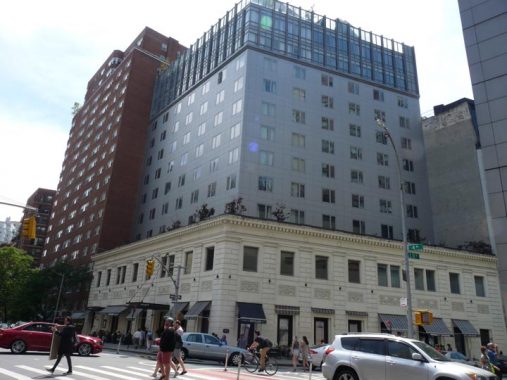
In 2013, the Hyatt Union Square Hoel was completed at 4th avenue and East 13th Street. It was constructed atop the empty shell of a two-story building was classical design that had been there for decades previously; Municipal Archives photos indicate that it had been a used car dealership.
The restaurant on the ground floor is called Bowery Road. 4th Avenue is the north extension, between Cooper and Union Squares, of the precolonial Native American trail that became the Bowery when it became the road to Peter Stuyvesant’s farm, which in Dutch was called a bouwerij.
Also in 2013, renovations to the 1898 #147 4th Avenue made it the True North hotel. 4th Avenue is one of the few streets on Manhattan that points to true north — check it out with the compass feature on your mobile device. Among the additions was a clock at the roofline.
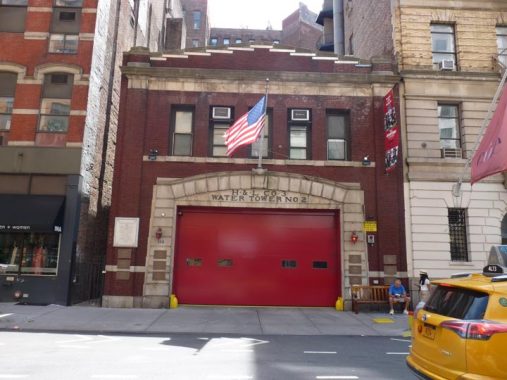
Hook & Ladder #3/Water Tower #2 was one of many firehouses around town built from 1929-1932, during a spate of construction under Mayor Jimmy Walker, whose name is on the plaque on the wall at the left. This company was among the hardest hit after the terrorist attack on 9/11/01, losing most of its men.
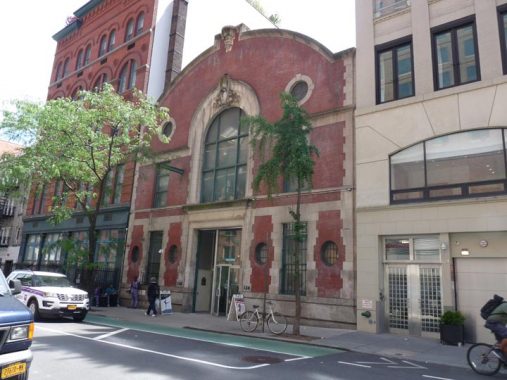
#126-128 East 13th, with its Beaux Arts design and rounded roofline, looks rather unusual and indeed, it’s a relic, one of NYC’s few remaining buildings constructed to auction horses, as Van Tassel & Kearney Auction Mart in 1903. It has also served as a candy factory, a vocational defense training school for women in World War II, the studio of artist Frank Stella, and as a dance studio. It has enjoyed NYC Landmarks Preservation Commission protection since 2012.
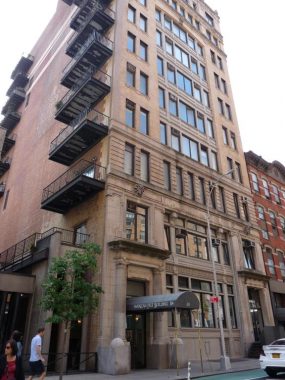
114 East 13th, the old American Felt Company building, now residences. There are a pair of stone rams’ heads above the second floor: felt is produced from rams’ wool.
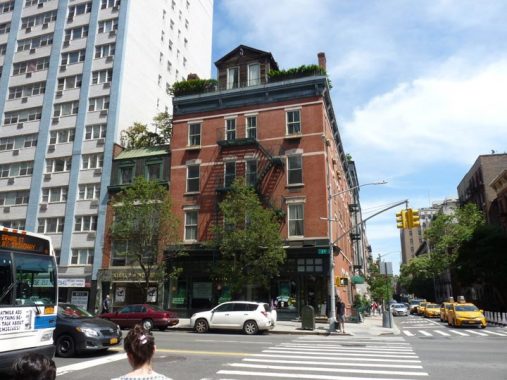
The NE corner of 3rd Avenue and East 13th is historic in two ways: a pear tree planted by Peter Stuyvesant himself stood here in what was originally his farm from 1647 to 1867, a span of 220 years. It only perished when two horse-drawn wagons crashed into it. It’s a matter of serendipity that it wasn’t in the path of East 13th Street, which was cut through in the 1820s. The plaque commemorating the long-lived tree was actually in the wrong place, on East 10th, for 46 years, from 1959-2005!
The apothecary on the corner, Kiehl’s, has only been there since 1851, so the tree and the drugstore shared the space for 16 years.
In a unique setting that features the original crystal-drop chandeliers hanging from a 1930s acoustic-tile ceiling the sales staff, outfitted in white lab coats, dispense in-depth advice and generous samples of the many facial cleansers, scrubs, toners, moisturizers, masques, shaving, sunscreen, hair care and baby care products.
Kiehl’s continues to offer essences, including Original Musk Oil, a sample of which was discovered in the store’s basement in the 1920s and, since its reintroduction in 1963, has become the most widely imitated fragrance in the world… Ellen Williams & Steve Radlauer, The Historic Shops & Restaurants of New York

New and old construction on 3rd Avenue and East 12th Street, the new Westside Market (which is actually on the East Side) at 84 3rd Avenue and prewar walkup buildings.
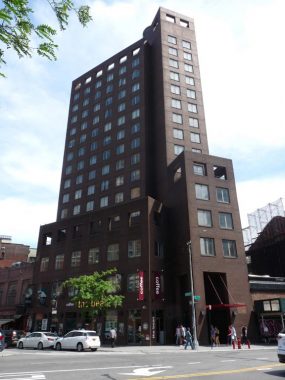
This unusually-angled building on 3rd Avenue north of St. Marks Place has a shape necessitated by the presence of Stuyvesant Street — one of the few east-west oriented streets in NYC, the former cartway to Peter Stuyvesant’s farm. The coffee shop on the ground floor was once home to the legendary St. Mark’s Bookstore.
Mr. Stuyvesant’s Garden [FNY]
Return to Stuyvesant Street [FNY]

The sun didn’t give me a great angle to shoot the famed Cooper Union in Cooper Square, so I just shot the south-facing portico today. Cooper Unionstill anchors Cooper Square as it has done since 1859. The school was founded by inventor Peter Cooper, who laid the first transatlantic cable, ran the first successful railroad, and was the first producer of edible gelatin (the father of Jell-O). The school’s great hall was where Abraham Lincoln launched his presidential campaign in 1860; other speakers have included Mark Twain, Frederick Douglass, Susan B. Anthony and presidents Grant, Cleveland, Taft, Theodore Roosevelt, Wilson, Clinton and Obama.

The Bowery (the name means ‘farm’ in Dutch and was originally the Bowery Road, which led past Peter Stuyvesant’s farm) splits in two at East 4th Street, becoming 3rd and 4th Avenues. However, not only the square but the roadways themselves are called Cooper Square all the way north to Astor Place.
Hidden in the shadows to the rear is Peter Cooper’s portrait rendering. Two giants in their field, Augustus St. Gaudens, and architect Stanford White, built this tribute to Peter Cooper, with St. Gaudens the sculptor and White designing the housing. The sculpture was unveiled in 1897. Purely coincidentally, the two men who did the most to shape this part of town were both named Peter: Stuyvesant and Cooper.
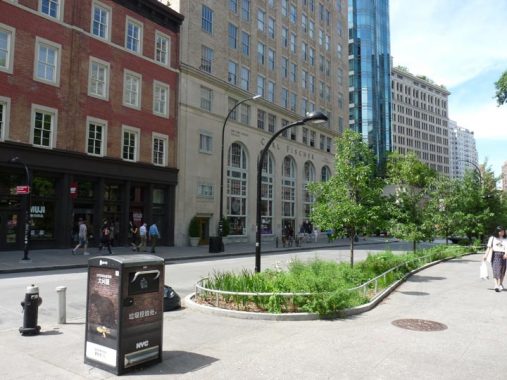
After resisting davits (curved-shafted lampposts with no attached mast) for decades, the NYC Department of Transportation got into them in a big way in the 2000s, lining streets like Houston in Manhattan and Columbia in Brooklyn with them. The davits in the Cooper Union area are painted black and have a set of Mini-Me versions that illuminate the sidewalks.
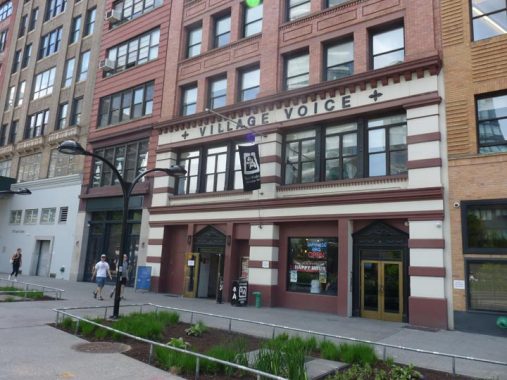
For decades New Yorkers visited newsstands on Wednesdays to get the latest Village Voice, founded in 1955, to read the best in journalism with a mostly leftwing bent, which didn’t prevent it from being NYC’s premier weekly newspaper (with competition from SoHo News and New York Press). The Voice cost a dollar until it was distributed for free for its last few years, and the print version published until late 2017. The online version survives with mainly archived content. The Voice was not loved just for its articles: it had very large entertainment and job listings that millions relied on.
The Voice‘s editorial offices bounced around the Village, with the final office located in Cooper Square.

The First Ukrainian Evangelical Pentacostal Church, Cooper Square and East 7th Street adjoining McSorley’s, was built as the Metropolitan Savings Bank in 1867 and boasts a French Second Empire mansard roof.
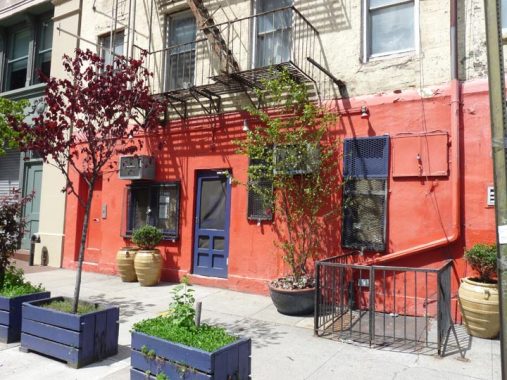
I regret that I didn’t get the chance to try the late, lamented Great Jones Cafe on Great Jones Street just off the Bowery. Established in 1983, it specialized in Cajun cuisine from Louisiana. The venue closed after the death of owner Jim Moffett in 2018.
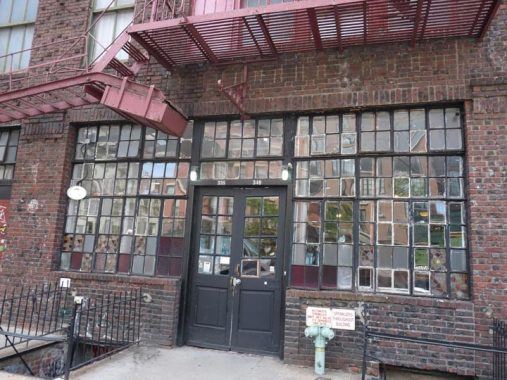
The Whitehouse Hotel, one of the Bowery’s last flophouses just south of Great Jones Street, has become a youth hostel (some small rooms go for $50 per night) in recent years. In 2009 the New York Times profiled some of its residents; in 2014, Curbed’s Hana Alberts stayed there (Alberts recently profiled yours truly for FNY’s 20th anniversary in the New York Post).

I’ve always been fond of the pure-white Italianate former Bouwerie Lane Theatre and Atlantic Savings Bank on the NW corner of Bowery and Bond Street. It was built in 1874 [Henry Engelbert, arch.] and served as a theater between 1963 and 2007, the longtime home of the Jean Cocteau Repertory Theater. It has been a designated NYC landmark since 1967.
Blondie’s Deborah Harry [1945- ] turned up on two separate wall murals on the Bowery, one an ad for an upcoming concert [in 2019] on Bleecker, the other on a protective steel gate south of Kenmare. A longtime New Jersey resident, she worked at a variety of jobs in New York City before settling on singing, first with folk band Wind in the Willows; she later became a part of the East Village scene at clubs such as CBGB. She formed Blondie with her future husband Chris Stein in 1974 and the band became a worldwide success with four #1 hits in the USA between 1978 and 1982. Blondie is still performing today. Harry’s memoir is set for a 2020 release.
Codex is Latin for “tree trunk” and by extrapolation, it also came to mean “ancient manuscript.” It is also the name of a new independent bookstore on the northeast corner of Bleecker and the Bowery.

The center building opposite Bleecker on the Bowery, containing the John Varvatos and Patagonia stores, is the former Palace Theater and for the better part of four decades, CBGB, the club opened by Hilly Kristal in the early 1970s that at first featured country music. Kristal, however, proved prescient when he began booking bands that were starting to percolate in the East Village scene in the mid-1970s including Blondie, the Ramones, and Television.
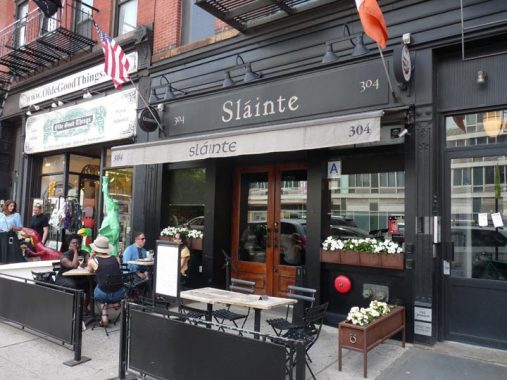
“Sláinte” means good health in Irish and is often offered as a toast. In English, it’s pronounced “slantcha.” The bar at 304 Bowery opposite East 1st Street has so far been able to weather the many changes the Bowery has undergone, with a new plethora of upscale apartment towers, over the past decade.
The Bowery Mission, at #227 between Rivington and Stanton, is a rescue mission, or project set up by a Christian group to aid the poor and sick, and a men’s shelter founded by Reverend Albert Gleason Ruliffson in 1876. It has owned its current building since 1896. In 2017 alone, it provided hundreds of thousands of meals and donated clothing and offered shelter, medical, dental and optometry exams. Donations are always welcome.

A somewhat dystopian tableau of the new mixed with the old on Bowery near Houston.
“The Bowery’s got its bums,” sang Jim Croce, and while the Bowery’s reputation as a gathering place for the down and out was justified, it’s also been a mecca for other things — a wholesale restaurant supplies center has been just south of Houston since the 1920s. Some of these outlets’ signs seem to be that old. I don’t know how old Globe Slicers’ handwritten sign has been there, but the store has been in business since 1947. Jeremiah Moss got in there a few years ago.
Just south of the restaurant supplies, on the Bowery north and south of Broome, is the wholesale lighting district. It seems a bit livelier, with imaginative signage that jumps out at you. Once again, wholesale lighting has been a Bowery feature since the 1920s, when the street was shadowed by an elevated train.

The Germania Bank Building, at Bowery and Spring, was constructed in 1896 and beginning in 1966, was the longtime home of photographer Jay Maisel and his family, who occupied the entire building’s 72 rooms. Maisel tolerated the graffitists and street artists who scrawled on the building’s exterior. Maisel had purchased the building for a little over $100K in 1966, and sold it in 2015 for $55 million. The ground floor is currently occupied by trendy clothing store Totokaelo, whose name reminds me of Toto Coelo (“I Eat Cannibals“)
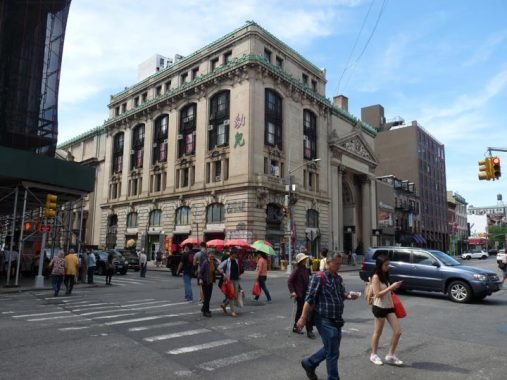
A McKim, Mead and White masterwork, the Bowery Savings Bank, rose from 1892-1894 on the Bowery at Grand, extending back to Elizabeth Street, when the Bowery was a theater district and the center of the NYC entertainment scene, and was still respectable — it didn’t descend into despair until the 1910s. This bank set the template for the Roman Classical Style revivals for subsequent bank buildings. Bowery Bank had stood in this location since 1834: this was the third building. The interior featured marble mosaic floors, yellow marble tellers’ counters, and cast-iron skylights and stairs. Thankfully the building has been saved and is now the Capitale nightclub.
After some mergers, the Bowery is now Capital One. Joe DiMaggio was the bank’s TV spokesman for many years.
The sculpted pediments, depicting bare-breasted women petting lions, were designed by Frederic MacMonnies, later famed for his Civic Virtue statue that has gone from City Hall Park to Queens Borough Hall to Brooklyn’s Green-Wood Cemetery.
Check out the ForgottenBook, take a look at the gift shop, and as always, “comment…as you see fit.”
7/7/19



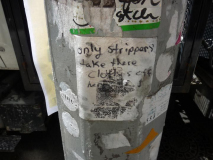
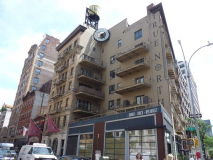
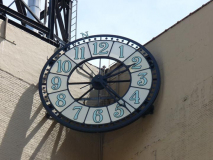
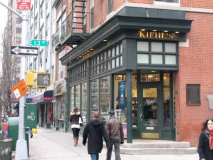
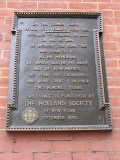
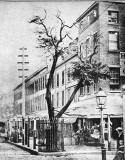

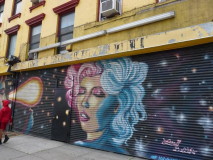
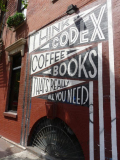
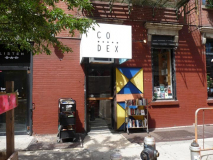
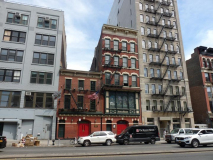
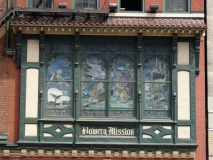
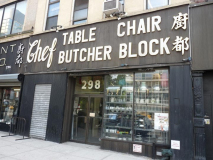
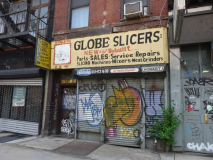
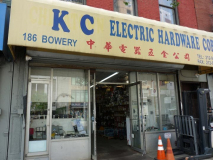
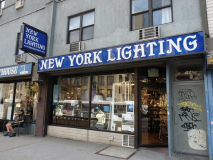
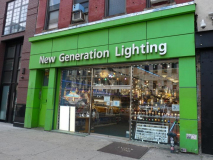
2 comments
Peter Stuyvesant
Peter Cooper
Peter Minuit (this Sunday)
hmmm?
Is there something about this island I don’t know about?
See you guys Sunday.
Codex doesn’t mean ancient manuscript, it means bound book. The normal modern book structure, with signatures made of folded and cut sheets sewn together into a folded cover, which makes accessing a specific page much easier than rolling through a scroll, was invented in about the 2nd or 3rd century in Egypt, the so-called “Coptic bindings”.